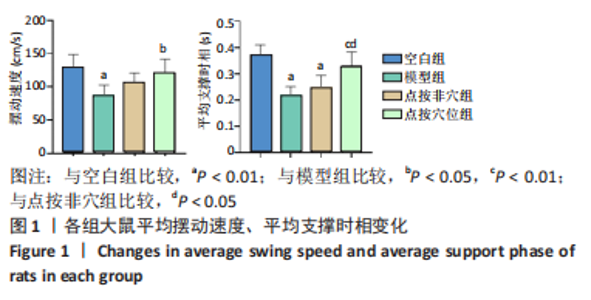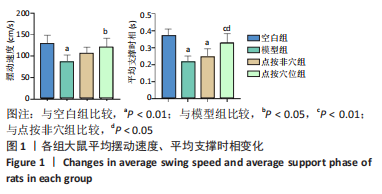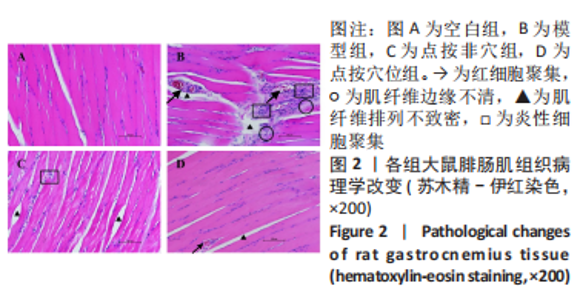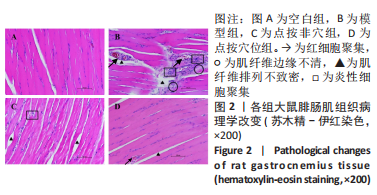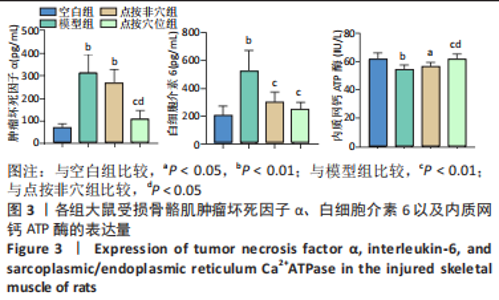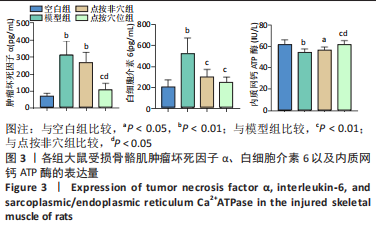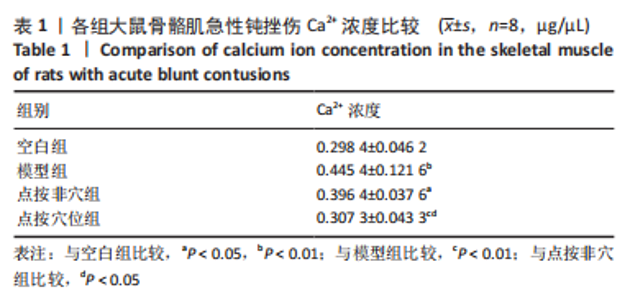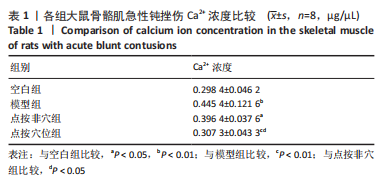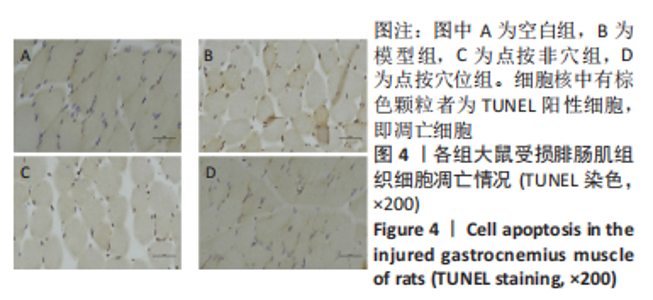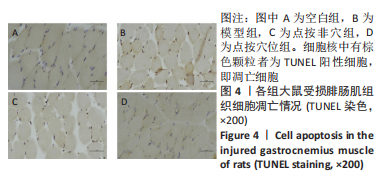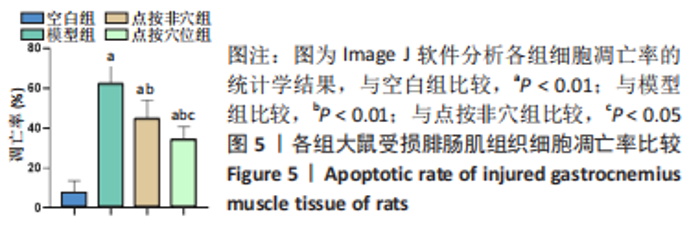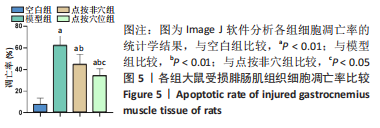[1] ISHØI L, KROMMES K, HUSTED RS, et al. Infographic. Diagnosis, prevention and treatment of common lower extremity muscle injuries in sport-grading the evidence: a statement paper commissioned by the Danish Society of Sports Physical Therapy (DSSF). Br J Sports Med. 2020;54(18):1116-1117.
[2] 张安宁,罗雪林,黄思琴,等. PI3K/Akt/mTOR信号通路在大鼠急性骨骼肌钝挫伤修复中的作用[J]. 中国运动医学杂志,2018,37(7): 594-600.
[3] CHIU CH, CHANG TH, CHANG SS, et al. Application of Bone Marrow-Derived Mesenchymal Stem Cells for Muscle Healing After Contusion Injury in Mice. Am J Sports Med. 2020;48(5):1226-1235.
[4] WANG S, YAN H, FANG B, et al. A myogenic niche with a proper mechanical stress environment improves abdominal wall muscle repair by modulating immunity and preventing fibrosis. Biomaterials. 2022;285:121519.
[5] 文颖娟,陈茉,赵欢,等. “脾主肌肉”与“线粒体质量控制”相关性研究[J]. 现代中医药,2022,42(3):1-8.
[6] 陈善文,温志立,林星镇. 浅谈“脾主肌肉”在相关疾病中的作用[J]. 江西中医药大学学报,2021,33(1):7-9.
[7] 郭宇鹏,刘子怡,李金双,等. 论脾主统血与动脉粥样硬化[J]. 云南中医中药杂志,2020,41(4):10-13.
[8] 任柏樾,姚辉,卢秉久. 泽明红山颗粒通过PI3K/AKT通路抑制NASH小鼠骨骼肌损伤[J]. 解剖科学进展,2021,27(4):417-420,424.
[9] 李红梅. 清代及清代以前阴陵泉穴临床应用文献研究[D].济南:山东中医药大学,2016.
[10] 郭大军. 小针刀配合针刺阴陵泉穴治疗肩周炎的临床效果[J]. 内蒙古中医药,2021,40(4):129-130.
[11] 肖祖伟,郑传华,刘智权,等. 围刺阴陵泉治疗膝关节鹅足区运动性损伤疗效观察[J]. 光明中医,2022,37(4):667-669.
[12] 吴安林,叶平,谢娇,等. 推拿对骨骼肌损伤修复相关生长因子影响研究进展[J]. 世界中医药,2019,14(3):548-552.
[13] OKONSKI R, ZHENG YM, Di Mise A, et al. Reciprocal Correlations of Inflammatory and Calcium Signaling in Asthma Pathogenesis. Adv Exp Med Biol. 2021;1303:319-331.
[14] QAISAR R, USTRANA S, MUHAMMAD T, et al. Sarcopenia in pulmonary diseases is associated with elevated sarcoplasmic reticulum stress and myonuclear disorganization. Histochem Cell Biol. 2022;157(1):93-105.
[15] XU H, VAN REMMEN H. The SarcoEndoplasmic Reticulum Calcium ATPase (SERCA) pump: a potential target for intervention in aging and skeletal muscle pathologies. Skelet Muscle. 2021;11(1):25.
[16] 张彦洁. 硫化氢信号在骨骼肌发生与胁迫响应中的生理功能[D].太原: 山西大学,2020.
[17] CRISCO JJ, JOKL P, HEINEN GT, et al. A muscle contusion injury model. Biomechanics, physiology, and histology. Am J Sports Med. 1994;22(5): 702-710.
[18] SAKUMA Y, MIYAGI M, INOUE G, et al. Muscle injury in rats induces upregulation of inflammatory cytokines in injured muscle and calcitonin gene-related peptide in dorsal root ganglia innervating the injured muscle. Muscle Nerve. 2016;54(4):776-782.
[19] 于天水,官大威,程子惠,等. 大鼠骨骼肌钝挫伤分级模型的建立[J]. 法医学杂志,2008,24(3):168-171.
[20] 林莺,纪峰,黄桂榕,等. 针刺实验研究中大鼠非经非穴选取方法及思考[J]. 针刺研究,2013,38(4):334-338.
[21] 陈采益,徐斌,喻晓春,等. 电针经穴与相应非经穴对大鼠心动过缓调节效应差异的研究[J]. 上海针灸杂志,2010,29(12):747-751.
[22] 李春华,赵雅芳,嵇波,等. 电针介入对痛经模型大鼠子宫微循环的影响[J]. 针刺研究,2011,36(1):12-17.
[23] 周红海,于栋. 中医筋伤学[M]. 北京:中国中医药出版社,2021.
[24] 向勇,王春林,董有康,等. 柔筋温通手法治疗慢性软组织损伤[J]. 河南中医,2018,38(12):1911-1914.
[25] 彭春平,邓多喜,彭亮. 推拿对划船运动员股四头肌扭挫伤的疗效观察及骨骼肌损伤机制探讨[J]. 按摩与康复医学,2017,8(23):38-40.
[26] 黄静. TRAIL、IL-10参与损伤大鼠骨骼肌细胞凋亡机制及其与气血变化相关性探索[D]. 成都:成都体育学院,2019.
[27] 王晓玲. 中医“脾主统血”核心名词的理论研究[D]. 沈阳:辽宁中医药大学,2016.
[28] 赵继荣,马同,邓强,等. 基于“脾主肌肉”理论探讨脾-肌肉-骨骼-骨质疏松性骨折间相关性[J]. 中国骨质疏松杂志,2019;25(1): 127-131.
[29] 苗红,王晓燕. 阴陵泉穴在《针灸大成》中的应用解析[J]. 山东中医药大学学报,2019,43(6):586-589.
[30] 张天文,李记泉,沈儒,等. 阴陵泉命名文化与临床意义[J]. 亚太传统医药,2019,15(9):211-213.
[31] 肖祖伟,郑传华,刘智权,等. 围刺阴陵泉治疗膝关节鹅足区运动性损伤疗效观察[J]. 光明中医,2022,37(4):667-667.
[32] 常新斗.针刺阴陵泉穴+拨穴通络推拿在肩周炎中的应用[J]. 实用中西医结合临床,2020,20(9):27-28.
[33] 汪文静,赵敬军,任萌,等. 应用Catwalk步态分析系统评价经颅脉冲电刺激对MCAO模型大鼠运动功能的作用[J]. 中华物理医学与康复杂志,2021,43(5):385-390.
[34] 林建平,王浩,郭明玲,等. 骨骼肌钝挫伤的损伤与修复机制研究进展[J]. 康复学报,2022,32(1):88-94.
[35] ZIEMKIEWICZ N, HILLIARD G, PULLEN NA, et al. The Role of Innate and Adaptive Immune Cells in Skeletal Muscle Regeneration. Int J Mol Sci. 2021;22(6):3265.
[36] 马闯. 基于肌浆网环境的骨骼肌多尺度建模与仿真[D]. 哈尔滨:哈尔滨理工大学,2021.
[37] 张耀. 一次性大负荷离心运动对大鼠骨骼肌线粒体内质网偶联(MAM)的影响[D].北京: 北京体育大学,2020.
[38] CHANDRA G, DEFOUR A, MAMCHOUI K, et al. Dysregulated calcium homeostasis prevents plasma membrane repair in Anoctamin 5/TMEM16E-deficient patient muscle cells. Cell Death Discov. 2019;5:118.
[39] TONG X, KONO T, EVANS-MOLINA C. Nitric oxide stress and activation of AMP-activated protein kinase impair β-cell sarcoendoplasmic reticulum calcium ATPase 2b activity and protein stability. Cell Death Dis. 2015;6(6):e1790.
[40] KILICKAP M,GURLEK A,DANDACHI R,et al.Tumour necrosis factor-alpha in diastolic dysfunction. Acta Cardiol. 2004;59(5):507-510.
[41] 任真. 镉的肾毒性机制和治疗-钙离子稳态和自噬失衡介导镉致肾脏损伤[D]. 镇江:江苏大学,2020.
[42] XIN Y, ZHANG Y, DENG S, et al. Vagus Nerve Stimulation Attenuates Acute Skeletal Muscle Injury Induced by Hepatic Ischemia/Reperfusion Injury in Rats. Front Pharmacol. 2021;12:756997.
[43] LAHMANN I, GRUGER J, CHEN JS, et al. Met and Cxcr4 cooperate to protect skeletal muscle stem cells against inflammation-induced damage during regeneration. Elife. 2021;10:e57356.
|
